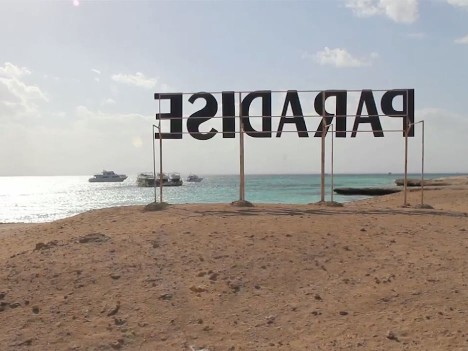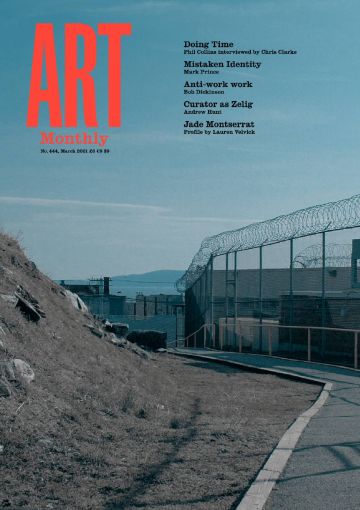Books
Art and Activism in the Age of Systemic Crisis: Aesthetic Resilience
Francis Frascina discovers the limits of this collection of essays focused on art that nurtures change

Dream Away film still from the cover of Art and Activism
The editors of this essay collection seek instances of art and activism that not only ‘contain and counter the pressure neoliberal social and political transformations have put upon communal and artistic life’, but also exemplify a ‘form of resilience, a form of art that nurtures and fosters our possibilities for change’. They take their inspiration from Stuart Hall’s Gramscian appeal, in The Hard Road to Renewal: Thatcherism and the Crisis of the Left, 1988, to develop a counterhegemonic strategy that avoids ‘thinking the same things we have always thought and doing the same things we have always done – only more so, harder and with more “conviction”’. For Hall, that meant moving on from mourning the loss of ‘1968’ by redefining the whole project of socialism under ‘present conditions’. The latter included the realities of Ronald Reagan and Margaret Thatcher’s systematic assaults on workers’ rights (trade unions and post-1945 welfare legislation), on state-funded institutions (museums, the NEA, educational establishments), on sites of difference and identity (ideological culture wars) and on leftist governments and organisations (from Nicaragua to CND). To resist these assaults, leftist emphases on the centrality of class struggle had to transform by embracing post-1968 liberation realities and theories, including identity and sexual politics, post-colonialism, feminist strategies, and the complexity of subjectivities and communities.
In this spirit, the 14 essays in Art and Activism in the Age of Systemic Crisis move across geographic locations, practices, inclusions/exclusions and forms of address. Some root their discussions in activism of the 1960s and 1970s while others focus on recent examples ranging from 2017’s Documenta 14 to photographic research and performance documentation in Brazil for a forthcoming exhibition. Those familiar with activist terrain will recognise both instances of institutional critique and debates about relational aesthetics as foundations for art/artist activism variously defined in terms of consciousness-raising, communitarian processes, occupations of radical spaces (actual or theoretical) within a system/place/institution, and pedagogic re-evaluations of marginalisation and oppression. As such, the essays include useful case studies of ‘aesthetic resilience’ as ways to nurture the survival of endangered radicalism – alternative and oppositional practices – in a rapacious corporate world that co-opts and markets critique and innovation even when under systemic crisis.
One lesson from Hall’s assessment of Thatcherism and the left is that wide-ranging art and activism, including related publications, have to avoid the criticism of special pleading or of disparateness in the face of systematic power, or of repeating past struggles that conjure up a sense of déjà vu, while disaster capitalism, corporate destruction of biodiversity and populism – as with the Trumpian storming of the Capitol in the pursuit of a ‘Gilead’ dream – steam ahead regardless. Similarly, there is the potentially demoralising realisation that small radical acts only achieve minor victories within a globalised system where power mutates under crisis and critique. A counter argument is that leftist artists and groups have to document/archive their own activities, their successes and debates, to prevent their being lost, neglected or forgotten within dominant institutionalised processes of record and representation. Given the financial and ideological power of metropolitan museums, galleries and institutionalised archives, the first task for marginalised communities/subjects is to establish the existence of places, processes and publications for their practices and historical representation as exemplified by the origins of the Studio Museum in Harlem, the PAD/D Archive (see my feature ‘Dematerialised and Dark’ in AM422) with its offshoot in Gregory Sholette’s ‘Dark Matter’ digital archive (Reviews AM344) and Daniel G Andújar’s net resource Technologies To The People, founded in 1994.
Although it has an exclusionary price tag of £120 per copy, Art and Activism contributes to this counter-argument, particularly as illuminated by Hall and Tony Jefferson’s 1975 anthology on the analysis of youth subcultures and resistance through rituals. For Hall and Jefferson, radical resistances produce resilient identities in the face of monolithic structures of power, a process recently represented by Steve McQueen’s evocation of the African proverb ‘If you are the big tree, we are the small axe’ (echoed in Bob Marley’s ‘Small Axe’ in the Wailer’s 1973 album Burnin’). McQueen’s five ‘Small Axe’ BBC broadcast films on black identity and struggles in the UK cut across the ‘big tree’ narratives of power that conjoin Enoch Powell’s 1969 ‘Rivers of Blood’ speech, Thatcherism, the Windrush Scandal and the Conservative Party’s Home Office policy of hostile environment and ‘sus’ laws.
The essays in Art and Activism provoke debates about how small acts of subversion and resilient practices of subcultural identity avoid marginalisation. How, too, do such acts avoid neglecting fundamental structural problems caused by poverty, modern slavery, oppression and nativism? Major dangers are not only that the political and economic system under crisis remains unscathed by disparate activism and cultural politics, but also that there are unpredictable political consequences to leftist action. Recent awareness of such dangers, especially in the context of Brexit, the election of President Donald Trump in 2016 and the electoral success of the Conservative Party despite years of ideologically imposed austerity, led many on the left to re-read Richard Rorty’s prescient Achieving Our Country: Leftist Thought in Twentieth-Century America, 1998. Rorty made a distinction between, on the one hand, the activities of the ‘political left’ in the interwar years that led, after 1945, to practical improvements – ranging from the NHS and the welfare state in the UK to progressive legislation on equal rights, race and poverty in the US – and, on the other hand, the ‘cultural left’ from the late 1970s onwards. For Rorty, the latter was characterised by a shift to emphases on academic theory, identity politics, culture wars and the politics of representation. He argued that an overemphasis on audiences, communities and constituencies focused on cultural politics could lead to a neglect of those who were at the centre of the political left’s struggles to establish workers’ rights, trade unions, the welfare state, universal education, positive conditions for social mobility and escape from poverty. Such neglect, he argued, could lead to communities that felt excluded from ‘cultural left’ discourse becoming ripe for the appeal of a populist demagogue or idea. In this sense, identity politics becomes reactionary as exemplified by a mostly white constituency (which has embraced the vagaries of social media, conspiracy theories and the slogan ‘fake news’) voting for Trump or for Brexit.
Both Hall and Rorty illuminate how systemic crisis produces the unexpected. Neither authors are prescriptive or proscriptive, but their texts are reminders of the difficulties posed for art, activism and the left when the past, and/or the full realities of present conditions, are either forgotten or neglected. Art and Activism would have been strengthened as a resource if more of the hard lessons of Rorty’s analysis and the full extent of Hall’s Gramscian critique had been systematically embraced.
Art and Activism in the Age of Systemic Crisis: Aesthetic Resilience, Elizabeth Steinbock, Bram Ieven, and Marijke de Valck, eds, Routledge, 2021, 212pp, 16 b/w illus, hb, £120, 978 0 367219 84 0.
Francis Frascina is an art historian and writer.
First published in Art Monthly 444: March 2021.










